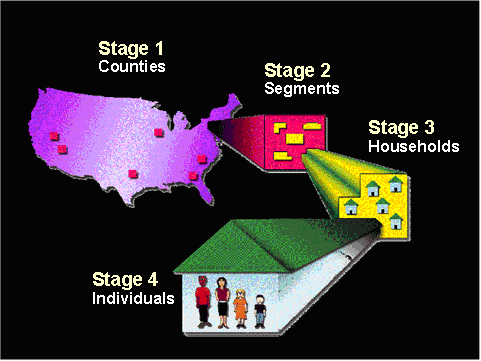Task 1: Key Concepts About the NHANES Survey Design
The NHANES sample is designed to be nationally representative of the civilian, non-institutionalized U.S. population, in that it does not include persons residing in nursing homes, institutionalized persons, or U.S. nationals living abroad. Thus, for NHANES 1999-2010, each year's sample and any combination of samples from consecutive years comprise a nationally representative sample of the resident, non-institutionalized U.S. population.
In order to have sufficient sample sizes to obtain stable estimates for population subgroups of common interest, NHANES data are released in 2-year cycles. Just as each year's sample is representative of the resident, non-institutionalized U.S. population, the same is true for these 2-year cycles of data.
Sampling Design
NHANES data are not obtained using a simple random sample. Rather, a complex, multistage, probability sampling design is used to select participants. The NHANES sampling procedure consists of 4 stages, shown and described below.
Four Stages of NHANES Sampling Procedures

Stage 1: Primary sampling units (PSUs) are selected from strata defined by geography and proportions of minority populations. These are mostly single counties or, in a few cases, groups of contiguous counties selected with probability proportional to a measure of size (PPS). Most strata contain two PSUs. Additional stages of sampling are performed to select various types of secondary sampling units (SSUs), namely the segments, households, and individuals that are selected in Stages 2, 3, and 4.
Stage 2: The PSUs are divided into segments (generally city blocks or their equivalent). As with each PSU, sample segments are selected with PPS.
Stage 3: Households within each segment are listed, and a sample is randomly drawn. In geographic areas where the proportion of age, ethnic, or income groups selected for over-sampling is high, the probability of selection for those groups is greater than in other areas.
-
Stage 4: Individuals are chosen to participate in NHANES from a list of all persons residing in selected households. Individuals are drawn at random within designated age-sex-race/ethnicity screening sub-domains. On average, 1.6 persons are selected per household.